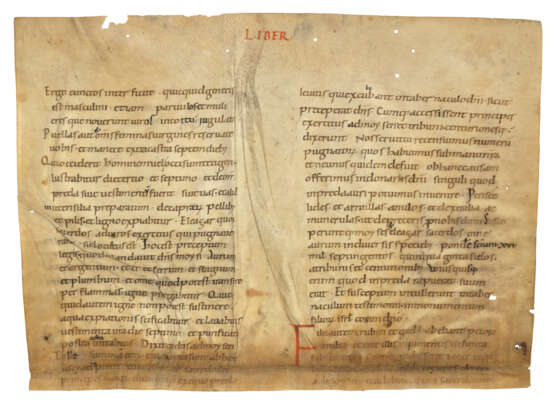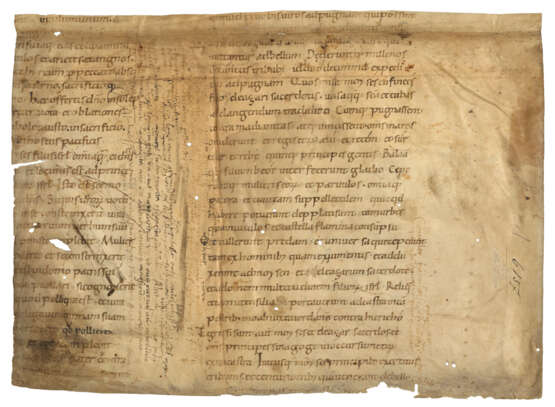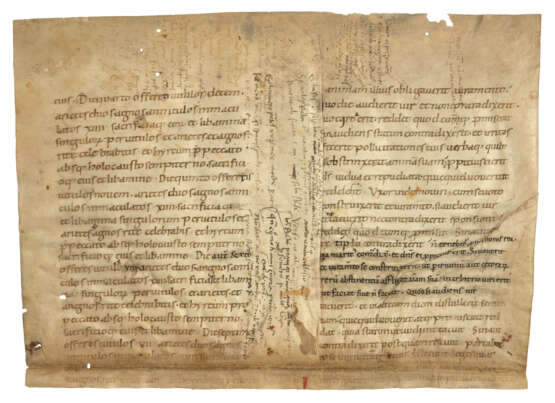ID 1249789
Lot 1 | A fragment from an early Bible
Estimate value
£ 5 000 – 8 000
A leaf from a Bible, in Latin, manuscript on vellum [France?, 10th century]
An handsome fragment from an exceptionally large Carolingian Bible, with 12th-century corrections.
Two fragments of a single leaf: c. 226 x 318mm and c.224 x 312mm, lacking one line between fragments and one line at the bottom, therefore the original leaf originally c.500mm high and two columns of 52 lines (50 visible here overall) written in a fine, large, legible and rounded Caroline hand, blind-ruled, the text containing Numbers 29:22-32:14, beginning :'[libamine] eius. Die quarto offeretis vitulos decem' and ending 'Et ecce inquit vos surrexistis [pro patribus vestris]', 12th-century corrections in a darker ink, heading and one large initial in red, with remnants of a second (recovered from use as binding fragments and therefore with creases, stains, some marginal soiling, a few wormholes, some natural flaws in the vellum). Provenance: A 16th-century hand has added numerous quotes from a Latin translation of Thucydides on the visible (when still in the binding) sides of both pastedowns – if these are quotes from the book whose binding incorporated the fragments it may have been a copy of an incunable edition of the Historia belli Peloponnesiaci, perhaps the one printed in 1483 by Johannes (Rubeus) Vercellensis, Thucycides' first appearance in print.
Script:
The script is extremely close to that of a late 9th/early 10th-century manuscript of the Frankish historian Nithard, now Paris, BnF, Latin 9768, produced in Soissons. Comparable features are the letter 'a' as a simple single-celled letter with no curling projection at the top, the 's' always in the long form, the 'g' in the form of two closed loops, and the relatively straight descender of 'q'. Ascenders on letters such as 'b', 'd', 'h' and 'l' tend to have wedged, and sometimes notched, tops - although this is less pronounced here than in the BnF manuscript. Interesting are the 12th-century corrections to the text, carefully executed in a darker ink by an accomplished hand: these perhaps represent an attempt at adaptation to the text established at the University of Paris later in the 12th century.
| Place of origin: | Italy, Europe |
|---|---|
| Auction house category: | Medieval & renaissance manuscripts, Books and manuscripts |
| Place of origin: | Italy, Europe |
|---|---|
| Auction house category: | Medieval & renaissance manuscripts, Books and manuscripts |
| Address of auction |
CHRISTIE'S 8 King Street, St. James's SW1Y 6QT London United Kingdom | |
|---|---|---|
| Preview |
| |
| Phone | +44 (0)20 7839 9060 | |
| Buyer Premium | see on Website | |
| Conditions of purchase | Conditions of purchase |






